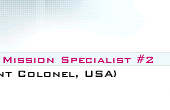  |
|
PERSONAL
DATA: Born December 29, 1958, in Wilmington, Delaware, but considers
Troy, Ohio, to be her hometown. Married to David W. Currie. They
have one daughter. She enjoys weight lifting, running, swimming,
scuba diving, and skiing.
|
 |
|
EDUCATION:
Graduated from Troy High School, Troy, Ohio, in 1977; received a
bachelor of arts degree in biological science from Ohio State University,
Columbus, Ohio, in 1980, a master of science degree in safety from
the University of Southern California in 1985, and a doctorate in
industrial engineering from the University of Houston in 1997.
|
 |
|
SPECIAL
HONORS: Honor Graduate of the Army Aviation Officer Advanced
Course (1986), NASA Flight Simulation Engineering Award (1988),
NASA Space Flight Medal (1993, 1995, 1998), Defense Superior Service
Medal (1993), Ohio Veteran's Hall of Fame (1994), Troy, Ohio Hall
of Fame (1996), Ohio State University Army ROTC Hall of Fame (1996),
Silver Order of St. Michael, Army Aviation Award (1997).
|
 |
|
 Dr. Nancy Currie is a veteran of three Shuttle flights and has logged
more than 737 hours in space. On STS-109, she will serve as Space
Shuttle Columbia's flight engineer and robotic arm operator. Using
the 50-foot robotic arm, she will gently pluck Hubble from its orbit
and ease it into Columbia's payload bay. During the five days of
spacewalks, she will maneuver the robotic arm while one of her crewmates
rides it to various locations around the bus-sized telescope. After
Hubble is refurbished, she will use the arm to carefully return
it to orbit. Although this is her first mission to Hubble, she and
fellow crewmate Dr. Jim Newman flew together on STS-88, the first
International Space Station assembly mission.
Dr. Nancy Currie is a veteran of three Shuttle flights and has logged
more than 737 hours in space. On STS-109, she will serve as Space
Shuttle Columbia's flight engineer and robotic arm operator. Using
the 50-foot robotic arm, she will gently pluck Hubble from its orbit
and ease it into Columbia's payload bay. During the five days of
spacewalks, she will maneuver the robotic arm while one of her crewmates
rides it to various locations around the bus-sized telescope. After
Hubble is refurbished, she will use the arm to carefully return
it to orbit. Although this is her first mission to Hubble, she and
fellow crewmate Dr. Jim Newman flew together on STS-88, the first
International Space Station assembly mission.
 In 1987, she began work at NASA's Johnson Space Center as a flight
simulation engineer on the Shuttle Training Aircraft, an airborne
simulator that models flight conditions of the Shuttle. NASA selected
her for the Astronaut Corps in 1990, and she served as a mission
specialist on STS-57, STS-70 and STS-88.
In 1987, she began work at NASA's Johnson Space Center as a flight
simulation engineer on the Shuttle Training Aircraft, an airborne
simulator that models flight conditions of the Shuttle. NASA selected
her for the Astronaut Corps in 1990, and she served as a mission
specialist on STS-57, STS-70 and STS-88.
 On her first flight, STS-57 in 1993, Currie functioned as the flight
engineer and robotic arm operator. This flight's main objective
was the retrieval of the European Retrievable Carrier satellite
(EURECA) with the robotic arm. The mission also featured a spacewalk
and the first flight of SPACEHAB, a commercially provided module
for science experiments. STS-57 helped refine procedures for the
historic Hubble repair mission, STS-61, later that year.
On her first flight, STS-57 in 1993, Currie functioned as the flight
engineer and robotic arm operator. This flight's main objective
was the retrieval of the European Retrievable Carrier satellite
(EURECA) with the robotic arm. The mission also featured a spacewalk
and the first flight of SPACEHAB, a commercially provided module
for science experiments. STS-57 helped refine procedures for the
historic Hubble repair mission, STS-61, later that year.
 In 1998, Currie served as flight engineer and robotic arm operator
on STS-88, the first International Space Station assembly mission.
This mission mated the first American-made module, Unity, to the
first Russian-made module, Zarya. Currie used the Shuttle's robotic
arm to retrieve Zarya from orbit and connect it to Unity. She also
operated the robot arm during the mission's three spacewalks, which
were performed a two-person team - including her current STS-109
crewmate Jim Newman.
In 1998, Currie served as flight engineer and robotic arm operator
on STS-88, the first International Space Station assembly mission.
This mission mated the first American-made module, Unity, to the
first Russian-made module, Zarya. Currie used the Shuttle's robotic
arm to retrieve Zarya from orbit and connect it to Unity. She also
operated the robot arm during the mission's three spacewalks, which
were performed a two-person team - including her current STS-109
crewmate Jim Newman.
|
 |
 |
 |
|

